
Trial begins for Canada 'Freedom Convoy' organisers
Tamara Lich and Chris Barber face mischief charges related to the 2022 truck protests in Ottawa.
www.bbc.com
Tamara Lich and Chris Barber each face counts of mischief and obstructing police.
The two were part of a group that led a convoy of lorries to Ottawa to protest against Covid-19 measures and Prime Minister Justin Trudeau's government.
Experts say the outcome of the trial could reverberate beyond the courts.
The main charge that Ms Lich and Mr Barber will have to defend is that of mischief, defined under Canadian law as the wilful destruction, damaging, obstruction, or interference of property.

